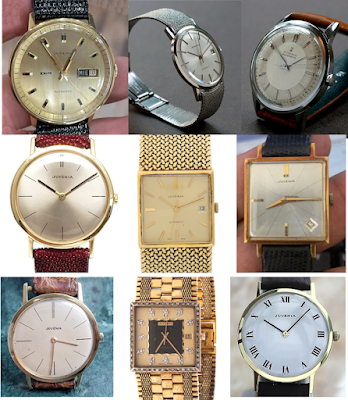By Bruce Shawkey
Juvenia is not often thought of as a "serious" watch company due to number of novelty watches they created over the decades. Yet the company produced many of its own movement Calibers and is just as serious as any other watch company as you will soon see. They are also one of the few Swiss watch companies to have manufactured watches continuously without interruption since its creation.
The beginning of the 20th century saw Juvenia flourish as it launched pocket watches with innovative designs. The first few years of the new century were also marked by massive expansion with the opening of two boutiques, in Paris and Madrid respectively, only decades after its founding.
Juvenia started to produce its own range of extra-flat movements in 1908 and became part of the small circle of watchmaking brands. Calibers included the smallest movement up to that time, measuring 9.5mm in diameter and 2.5mm thick.
Inspired by the sextant, a navigation tool for measuring the angular distance between two points, Juvenia in
In 1945, Juvenia introduced the Arithmo. It displayed the results of mathematical calculations above the 12 o'clock mark. It maintains a cult following among watch enthusiasts.
In 1947, Juvenia released the models that are probably most familiar to watch collectors, the "Mystere" collection (example at left) which display the time with two disks upon which the hands are attached. Collectors sometimes confuse these with Ernest Borel's "Cocktail" watches, but they are distinctly different.
A year later Juvenia created a women's rectangular watch with a sphere at each of the case tips. the Atlantide (right).
In 1950, Juvenia introduced the Trigone and Planet (left. The hands of these models moved like planets in the sky and formed, as the hours went by, different shapes from the star to the pyramid. The watches were near impossible to tell the time. They were quite expensive, and did not sell very well. I have only ever seen a photo of one (lefy) and only one advertisement for the models.
Watch Cases made from gold coins were all the rage at the beginning of the 1960s. Juvenia met demand by offering timepieces made with 10 and 20 dollar American gold coins (right). These are greatly prized among serious Juvenia collectors.
We'll take a pause to note that Juvenia made many conventional watches as well. These were Juvenia’s “bread-and-butter” watches that allowed the company artistic freedom on their more unconventional watches. A sampling of those is seen below.
In 1969, Juvenia introduced the Milanais collection (left), simple designs where the bracelet is integrated with the case.
By 1970, Juvenia joined with Ebel and Eberhardt to form Communauté d'Horlogerie de Précision. This gave the company access to the Beta 21 quartz watch project. The company also focused throughout the 1970s on ladies watches, especially jeweled and precious metal pieces.
In 1982 Juvenia launched the Number One collection, a modern interpretation of thin watches with steel cases and bezels made from 18K yellow gold.
In 1988, Juvenia was acquired by Asia Commercial Company of Hong Kong. The brand was re-launched, though the focus on hand-made jewelry watches remained. The company launched with a pave diamond watch and coin watch for ladies or men. They even created a new quartz Mystere model in 1992, with diamond-set bezel. But the name Mystere had lost its meaning, with a Skeleton Mystere and later gents model lacking the namesake mystery dial.
In 1993 Juvenia presented a "Golden age" collection (sample at right) that signaled an end to new avant garde creations, though the company continues to produce their iconic designs introduced decades ago that are still fresh today.
In 2002 Juvenia presented some of its most extraordinary collection of pieces. Embellished with 26 trapeze-cut diamonds, a hand-decorated skeleton movement, an 18K gold case, an enameled bezel and engraved with two dragons, the "Mythique" timepieces were as much works of art as timepieces.
Juvenia certainly did not abandon traditionally designed watches during this period. Clean and simple designs prevailed as Juvenia continued to cater to this market which represented their bread and butter watches.
Not much is written in the trade press about Juvenia from 2002 to the present, but the company continues to offer many wristwatches, ranging from the conventional to the unusual.

Bruce Shawkey
The Juvenia brand was seen as early as 1905, though it may have been used earlier. In 1908, Juvenia began producing their own in-house movements, focusing on compact and ultra-thin movements for ladies watches. Another early innovation was the 1945 Juvenia Arithmo, a slide rule watch for pilots.
Juvenia was made famous by their pioneer mystery dial watches, the Juvenia Mystère. First registered in 1945 and launched in 1947, the Mystère was released in many different forms in the 1950s, including a wrist watch, pendant, and table clock. The original Mystère was available in both round and square cases, with hour and minute hands protruding from the central dial into an outer track, transparent front and back. This was joined by a rounded rectangle version in 1952, Mystère Automatic and compact Mystère Lilliput in 1953.
Other unusual models include the 1955 Juvenia Trigone, with overlapping rotating triangles in a transparent case for hour and minute hands; the Juvenia Planéte, with eccentric discs; and the Juvenia Sextant, with a semi-circular hour hand. I have never seen an actual specimen of the Mystery Dial models. They did not sell very well due to the fact they difficult to tell the time.
Here are some Juvenia watches through the decades:
 |
| 1940s |
 |
| 1950s |
 |
| Arithmo |

 |
| Mid-'50s |
 |
| Mystery Dial Models |
 |
| Planete Mystery Dial |
 |
| Tigone Mystery Dial |
 |
Mystère Lilliput  |

.jpg)













I really do enjoy your recent articles and share your interest in these forgotten brands! I wonder if my own research on Juvenia, as documented on watch-wiki.net, perhaps served as a reference for you?
ReplyDelete